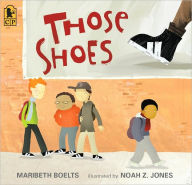A Monster Calls: Inspired by an idea from Siobhan Dowd by Patrick Ness and illustrated by Jim Kay Published by Candlewick: Massachusetts, 2012
Connor is a thirteen year old boy who is terrorized by a monster in his yard that comes to him at 12:07 am. It continuously demands the truth from Connor. During the day, Connor must deal with his mother having cancer and undergoing treatments.
 Appropriate target audience: Children ages 9 and up
Appropriate target audience: Children ages 9 and up
- Strengths: The illustrations enhance the frightening and emotional story that is told in the words on the page. This book is emotionally charged in a very masculine way and will appeal to reluctant readers.
- Weaknesses: The monster concept may frighten younger readers.
- Meaningful/Creative Uses: 1. Connor’s monster looks like a tree in his backyard. Take children on a nature walk with a sketch pad and have them find something in nature that they could turn into a monster. Create a display of the children’s monsters. 2. Taking the monster display further, have children record one frightening truth. Have a QR code by the monster and the scary truth sentence will play when the QR code is scanned.
- Awards: Carnegie Medal and Katie Greenway Award winner, 2012 (first book to win both prizes simultaneously)
- Other: The book was started by Siobhan Dowd who began the story when she was facing terminal cancer. She died while the book was still unwritten.
- Read-a-likes: More than This by Patrick Ness and Published by Candlewick: Mass, 2013
![More Than This by [Ness, Patrick]](https://images-na.ssl-images-amazon.com/images/I/61eNxGDixKL.jpg) Seth drowns. However, he wakes up and isn’t where he is. Did he really die?
Seth drowns. However, he wakes up and isn’t where he is. Did he really die?
Sadako and the Thousand Paper Cranes Eleanor Coerr and Illustrated by Ronald Himler Published by Puffin Books: London, 2004  A race winning Japanese girl becomes terminally ill due to the atom bomb dropped on Hiroshima. She starts making paper cranes while in the hospital.
A race winning Japanese girl becomes terminally ill due to the atom bomb dropped on Hiroshima. She starts making paper cranes while in the hospital.

 anything apocalyptic. He is searching for the extraordinary from his ordinary life.
anything apocalyptic. He is searching for the extraordinary from his ordinary life. suburb in New Jersey. She quickly makes friends and they form a pre-teen secret club. They discuss bras, menstruation, and boys. Margaret struggles with her lack of a formal religion. Her father is Jewish and her mother Christian which created strife within their extended family. She talks to God but claims she doesn’t have a religion which baffles her secret club friends.
suburb in New Jersey. She quickly makes friends and they form a pre-teen secret club. They discuss bras, menstruation, and boys. Margaret struggles with her lack of a formal religion. Her father is Jewish and her mother Christian which created strife within their extended family. She talks to God but claims she doesn’t have a religion which baffles her secret club friends. Linda does a report on whales. She is 20 pounds or so overweight and the class begins to call her “Blubber.” Even Jill who knows it’s wrong calls her “Blubber.”
Linda does a report on whales. She is 20 pounds or so overweight and the class begins to call her “Blubber.” Even Jill who knows it’s wrong calls her “Blubber.” Published by Yearling, Reprint Edition: New York, 1988
Published by Yearling, Reprint Edition: New York, 1988 Mattie Bean has moved to a new town with her mother. She wants to be the custodian’s apprentice so she doesn’t have to face the lunchroom and other social situations as the “new girl” again.
Mattie Bean has moved to a new town with her mother. She wants to be the custodian’s apprentice so she doesn’t have to face the lunchroom and other social situations as the “new girl” again. Illustrated by Annie Crawley Published by Millbrook Press: Minnesota, 2014
Illustrated by Annie Crawley Published by Millbrook Press: Minnesota, 2014 York, 2009
York, 2009


 blog contains story times, fun kids’ activities, book reviews, and much more!
blog contains story times, fun kids’ activities, book reviews, and much more!
 Director/animator – Pete List
Director/animator – Pete List
 It is a nature magazine that has been in publication since 1967. The magazine has science articles about nature, puzzles, activities, and games. This is appropriate for kids ages 7-12.
It is a nature magazine that has been in publication since 1967. The magazine has science articles about nature, puzzles, activities, and games. This is appropriate for kids ages 7-12.
 Bink and Gollie are unlikely best friends. Bink is a short, messy, unsophisticated girl who loves bright socks and her fish, Fred. Gollie is tall, chic, loves pancakes and imaginary adventures. This is an easy to read brilliantly illustrated story of the exploits of these friends.
Bink and Gollie are unlikely best friends. Bink is a short, messy, unsophisticated girl who loves bright socks and her fish, Fred. Gollie is tall, chic, loves pancakes and imaginary adventures. This is an easy to read brilliantly illustrated story of the exploits of these friends.
 Princess Magnolia transforms into the Princess in Black when the monster alarm sounds. This unusual princess wears a black cape and mask to fight the monsters. Even though readers are privy to her secret identity, it is truly a secret in this fun series for young readers.
Princess Magnolia transforms into the Princess in Black when the monster alarm sounds. This unusual princess wears a black cape and mask to fight the monsters. Even though readers are privy to her secret identity, it is truly a secret in this fun series for young readers.
 Published by Dial Books: New York, 1991 Grace loves to imagine herself as different characters from books. When her school announces the play she wants to be Peter Pan. The other kids in her class decide that she cannot be Peter Pan because she is a girl and she is black.
Published by Dial Books: New York, 1991 Grace loves to imagine herself as different characters from books. When her school announces the play she wants to be Peter Pan. The other kids in her class decide that she cannot be Peter Pan because she is a girl and she is black. CJ and his grandma ride the bus together. They are in an urban area and CJ wants to know why they do not have things other people do. He also wants to know why their street is so dirty. The grandma answers each question in an optimistic way to help CJ see the beauty in his world.
CJ and his grandma ride the bus together. They are in an urban area and CJ wants to know why they do not have things other people do. He also wants to know why their street is so dirty. The grandma answers each question in an optimistic way to help CJ see the beauty in his world. Published by Candlewick Press: Massachusetts, 2009
Published by Candlewick Press: Massachusetts, 2009